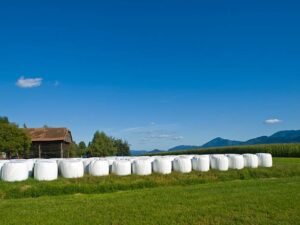Silage wrap helps safeguard bales of hay or straw against moisture and other elements, keeping them fresh for use as animal winter feed. Furthermore, silage wrap is 100 percent biodegradable making it an eco-friendly alternative to plastic film.
Built for optimal performance, this 5-layer co-extruded silage wrap keeps out oxygen and humidity, as well as providing great puncture and tear resistance. To learn about the silage wrap price 2023, click here.
Keeps Bales Fresh
 Oxygen ingress can quickly spoil hay, decreasing nutritional value of silage for livestock. To minimise oxygen ingress, use high-quality bale wrap that creates an effective barrier against air ingression.
Oxygen ingress can quickly spoil hay, decreasing nutritional value of silage for livestock. To minimise oxygen ingress, use high-quality bale wrap that creates an effective barrier against air ingression.
Silage wrap can also help combat weed growth. By blocking sunlight and moisture, silage wrap can stop weeds from appearing and save both time and money on manual weeding services.
Silage wrap can also help prevent soil erosion by sealing rotted forage into the ground, which prevents liquid penetration and prolongs freshness, particularly important during drought conditions. Furthermore, silage wrap protects bales from pest infestation; farmers should regularly check on them to make sure animals or rodents haven’t chewed at them, to save both costs and time spent rewrapping bales.
Keeps Pests Out
Silage wrap provides essential protection for fodder from pests like weeds and insects while also helping the plants from drying out during storage. It offers an environmentally friendly alternative to chemicals.
Ideal baleage moisture content should range between 40-55% for optimal fermentation and long-term storage, as well as reduced dry matter loss during harvesting.
Utilising bale wrap is one of the most reliable solutions, being both organic and completely safe for the environment. This makes it one of the best options available today.
Good quality silage wrap is also distinguished by an effective weed repellent known as RaniRepel that is extruded into the film during production, providing long-term solutions to weed issues. This makes them the ideal solution for farmers looking to preserve the freshness of hay bales while creating premium silage fodder. To learn about the silage wrap price 2023, click here.
Keeps Bales Airtight
Silage wrap is a form of plastic film designed specifically to wrap bales of silage, providing significant gains to both agriculture and livestock performance. Furthermore, silage wrap reduces costs associated with weed management by eliminating the need for herbicides or manual removal of unwanted vegetation.
Plywood bales feature a firm and sturdy material that forms an airtight seal when stored, keeping out moisture during storage. UV stabilisers help prevent degradation from sunlight exposure, making this material perfect for long-term outdoor exposure and making silage storage simpler than ever.
Film storage should take place on a clean surface free from debris or crop stubble, to avoid potential damage when handling or moving wrapped bales. Wrapped bales should also be kept out of direct sunlight as fermentation starts and should only be moved once they have completely cooled to prevent accidental gas bursting during transport. Furthermore, waiting 24 hours between handling wrapped bales to move them prevents them from becoming contaminated with spoilage bacteria or spoilage spoilage.
Recyclable
Silage wrap is composed of low-density polyethylene (LDPE). This material was specifically created for silage wrapping, providing strength and durability necessary to preserve its contents while being easily recyclable and reusing again and again.
Farmers can recycle silage wrap at Echuca or Mt Scobie Resource Recovery Centres along with netting and twine. It is important that it remains separate from other forms of waste to ensure that it stays clean and dry, thus helping prevent contamination that could harm livestock. To learn about the silage wrap price 2023, click here.
Silage wrap can keep hay and straw fresh and nutritious until it is needed to feed livestock, helping reduce costs during times when fresh food supplies are limited and increasing nutritional values for those animals that consume it.
